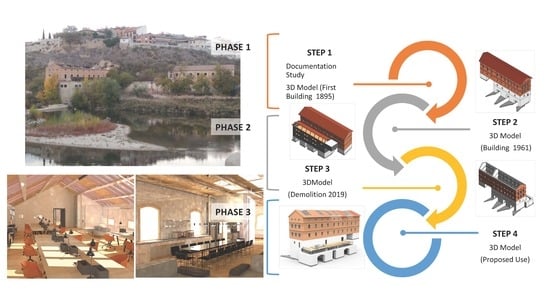Academic Proposal for Heritage Intervention in a BIM Environment for a 19th Century Flour Factory
Abstract
:1. Introduction
2. Materials and Methods
2.1. BIM Implementation in Final Projects in Engineering Degrees
2.2. Project Proposal: Heritage Intervention as Final Projects in Engineering Degrees
3. Academic Feedback Results & Discussion
4. Project Proposal: Heritage Intervention Results & Discussion
4.1. Phase 1. First Step: Original Condition
4.2. Phase 2. Second Step: Current Condition
4.3. Phase 2. Third Step: Demolition Stage
4.4. Phase 3. Fourth Step: Good Practices
- Spaces will be established to show the past history of the building and what occurred inside it, as well as the context in which it developed its activity. For this purpose, on the ground floor, a large part of the space will be dedicated to an exhibition of the past life of the building, with all its circumstances and characteristics, and the historical and economic context in which its activity developed. Likewise, space will be provided on each floor for sample activities that were carried out on that floor to assimilate each space with its function and original condition and contrast it with the new use.
- The industrial character of the building and all the elements that make it up will be maintained.
- Everything from the past will be preserved, respecting its authenticity and originality, that is, nothing of what remains will be modified, leaving imperfections that pose no risk.
- The industrial aesthetic will be preserved in the new-use development, but with the character of the current style, to achieve a pronounced contrast. What is added because of the needs of the new use will maintain the industrial character to the greatest extent possible: wide open spaces, concrete and defined uses of space, groups of simple and functional furniture, lighting from the roof, transit spaces, and evident circulation.
- With the new use, accessibility to cultural heritage in general will be promoted, as well as the protection of heritage assets of the complex in particular, both material and immaterial (processes, techniques, etc.), and their visualization for their knowledge. The use will be partially public, allowing visitors who do not want to use residency and coworking services access to all floors of the building and, thus, to the small sample activities on each floor; however, access will not be granted to the entire space on each floor, except the ground floor, which coincides with the largest exposition. Therefore, access to knowledge about the factory will also be guaranteed through accessibility devices needed to ensure full access.
- The responsible use of resources will be ensured in the new-use development and the linked rehabilitation process, contributing in turn to the sustainable, social, economic, and environmental development of the environment. The new-use development will incorporate, through current technology, the generation of energy through the motive power of water. Likewise, the interventions will focus mainly on conservation, limiting those of new construction to what is explicitly necessary. The new use will also fit perfectly with the possibilities of space: Large and ample spaces, good lighting, neutral colors, etc. It will also contribute to the economic growth of the community as a generator of jobs and wealth and, at the same time, will act as a new cultural space available to the entire society.
- Reconstruction, that is, the return to an earlier condition, will be considered as a final option. Everything that remains will be reinforced and conserved in its current condition, without reconstructing anything except in cases of fall risks, in which the necessary elements will be reinforced to mitigate the risk. Conservation of the original condition modified by the passage of time and neglect will be prioritized to help raise awareness about the importance of heritage protection, as it is not possible to recover what has been allowed to disappear.
- The environment in which the building is located and its peculiar natural characteristics will be protected. The environment will be maintained in its current condition, except for necessary cleaning and repair tasks. The first channel will reopen to harness energy from the river. In addition, within the exhibition established on the ground floor, there will be a section dedicated to explaining the natural environment and its importance with respect to the factory.
- The authenticity and originality of the building will be protected and highlighted in contrast to the new-use development, which will be defined with a different style and materials. Metal, glass and plastic will be used in an equally industrial style that contrasts with what already exists. New furniture will be perceived, to the greatest extent possible, as elements foreign to the place.
- The new use should promote a change in the significance that neighbors associate with the factory, from negative to positive. The new-use development will take advantage of the positive significance associated with the Simancas General Archive to revalue itself as a new cultural and research center of the municipality and contribute to economic development, which will also result in appreciation from the community.
- The new design will be aimed at making the most of the space, thus following the maxim form follows function. The design applied to the new-use development will be adapted to the existing conditions. Therefore, each plant will have a specific function, and the design will be adapted to take full advantage of the space and existing elements for the performance of the same, with the addition of new construction components if necessary.
- Each floor has a specific function, similar to when it functioned as a flour factory;
- Open, wide, and luminous spaces, and transit spaces on the central axis;
- Materials in contrast to the existing ones: plastic, glass, and metal, as a priority, and treated and stained wood;
- Metal as structural material to maintain the industrial character;
- Zenithal lighting to accentuate the verticality of the space;
- Simple and functional furniture (Figure 9), and clean lines and contours; and
- Reestablish the use of water as the energy supply for the building, contributing to sustainable development.
5. Conclusions
Author Contributions
Funding
Acknowledgments
Conflicts of Interest
References
- De Naeyer, A.; Arroyo, S.; Blanco, J. Krakow Charter: Principles for Conservation and Restoration of Built Heritage; Bureau Krakow: Krakow, Poland, 2000. [Google Scholar]
- Muñoz, A. Leopoldo torres balbás y la teoría de la conservación y la restauración del patrimonio. Papeles Partal Rev. Restaur. Monum. 2014, 6, 55–82. [Google Scholar]
- Juan, C.G.I.L.; Ángel, S.P.M. Aproximación y Propuesta de Análisis del Patrimonio Industrial Inmueble Español; UNED: Madrid, Spain, 2016. [Google Scholar]
- Sobrino, J. Carta de Sevilla de Patrimonio Industrial 2018. Los Retos del Siglo XXI; Fundación Pública Andaluza Centro de Estudios Andaluces, Consejería de la Presidencia, Administración Pública e Interior; Junta de Andalucía: Sevilla, Spain, 2019. [Google Scholar]
- Benito del Pozo, P.; Calderón, B.; Ruiz-Valdepeñas, H.P. La gestión territorial del patrimonio industrial en Castilla y León (España): Fábricas y paisajes. Investig. Geogr. 2016, 2016, 136–154. [Google Scholar] [CrossRef]
- Guited, F.G. Guía Fabril e Industrial de España; Librería Española: Madrid, Spain, 1862. [Google Scholar]
- Gútiez, A.C. Ministerio de Educación Cultura y Deporte. In Plan Nacional de Patrimonio Industrial; Secretaría General Técnica, Subdirección General de Documentación y Publicaciones: Madrid, Spain, 2015. [Google Scholar]
- Tagil, N. Carta de Nizhny Tagil Sobre el Patrimonio Industrial; The International Council of Monuments and Sites (ICOMOS) and The International Committee for the Conservation of the Industrial Heritage (TICCIH): Paris, France, 2003. [Google Scholar]
- Brandi, C. Teoría de la Restauración. Versión Española de María Angeles Toajas Roger; Alianza Roma: Madrid, Spain, 1993. [Google Scholar]
- Ruskin, J.; Estarico, L.; Burgos, C.D. Las Siete Lámparas de la Arquitectura; El Ateneo: Buenos Aires, Argentina, 1944. [Google Scholar]
- Viollet-Le-Duc, E.E. Entretiens sur L’architecture; Pierre Mardaga: Bruxelles, Belgium, 1986. [Google Scholar]
- Balbás, L.T. En Torno a la Alhambra; Al-Andalus: Madrid, Spain, 1960; Volume XXV, pp. 94–110. [Google Scholar]
- Logothetis, S.; Delinasiou, A.; Stylianidis, E. Building information modelling for cultural heritage: A review. ISPRS Ann. Photogramm. Remote Sens. Spat. Inf. Sci. 2015, 2, 177–183. [Google Scholar] [CrossRef]
- Nieto, J.E.; Moyano, J.J.; Rico, F.; Antón, D. Management of built heritage via HBIM project: A case of study of flooring and tiling. Virtual Archaeol. Rev. 2016, 7, 1–12. [Google Scholar] [CrossRef]
- Fai, S.; Graham, K.; Duckworth, T.; Wood, N.; Attar, R. Building information modelling and heritage documentation. In Proceedings of the 23rd International Symposium; International Scientific Committee for Documentation of Cultural Heritage (CIPA): Prague, Czech Republic, 2011. [Google Scholar]
- Maltese, S.; Tagliabue, L.C.; Cecconi, F.R.; Pasini, D.; Manfren, M.; Ciribini, A.L.C. Sustainability assessment through green BIM for environmental, social and economic efficiency. Procedia Eng. 2017, 180, 520–530. [Google Scholar] [CrossRef]
- Garagnani, S.; Manferdini, A. Parametric accuracy: Building information modeling process applied to the cultural heritage preservation. Int. Arch. Photogramm. Remote Sens Spat. Inf. Sci. 2013, 5, 87–92. [Google Scholar] [CrossRef]
- Jiménez-Roberto, Y.; Sebastián-Sarmiento, J.; Gómez-Cabrera, A.; Leal-Del, C.G. Analysis of the environmental sustainability of buildings using BIM (building information modeling) methodology. Ing. Compet. 2017, 19, 241–251. [Google Scholar] [CrossRef]
- Fadeyi, M.O. The role of building information modeling (BIM) in delivering the sustainable building value. Int. J. Sustain. Built Environ. 2017, 6, 711–722. [Google Scholar] [CrossRef]
- Bonenberg, W.; Wei, X. Green BIM in sustainable infrastructure. Procedia Manuf. 2015, 3, 1654–1659. [Google Scholar] [CrossRef]
- Azhar, S.; Hein, M.; Sketo, B. Building information modeling (BIM): Benefits, risks and challenges. BIM-Benefit [en línea] 2008, 18, 11. [Google Scholar]
- Julián, J.E.N.; Moyano, J.; Delgado, F.R.; Antón, D. La Necesidad de un Modelo de Información Aplicado al Patrimonio Arquitectónico. In 1er Congreso Nacional BIM-EUBIM 2013, Valencia, 24 y 25 de Mayo; Universitat Politècnica de València: Valencia, Spain, 2013. [Google Scholar]
- Iglesias, M.Á.G. Ley 9. Ley 9/2017, de 8 de Noviembre, de Contratos del Sector Público, por la que se Transponen al Ordenamiento Jurídico Español las Directivas del Parlamento Europeo y del Consejo 2014/23/UE y 2014/24/UE, de 26 de febrero de 2014. 2017. [Google Scholar]
- Caballero, M.B.; Pérez, P.Z.; Fernández-Coppel, I.A.; Lite, A.S. Implementation of BIM in the subject technical industrial projects—Degree in industrial technologies engineering—University of Valladolid. In Project Management and Engineering Research; Muñoz, J.L.A., Blanco, J.L.Y., Capuz-Rizo, S.F., Eds.; Springer International Publishing: Champaign, IL, USA, 2017; Volume 201, pp. 247–260. [Google Scholar]
- Rouyendegh, B.D.; Can, G.F. Selection of working area for industrial engineering students. Procedia Soc. Behav. Sci. 2012, 31, 15–19. [Google Scholar] [CrossRef] [Green Version]
- Poljanšek, M. Building Information Modelling (BIM) Standardization; JRC Joint Research Centre: Ispra, Italy, 2017. [Google Scholar]
- Rojas-Sola, J.I.; López-García, R. Engineering graphics and watermills: Ancient technology in Spain. Renew. Energy 2007, 32, 2019–2033. [Google Scholar] [CrossRef]
- Sola, J.I.R.; Fuente, E. La esclusa de émbolo buzo de agustín de betancourt: Análisis de su construcción mediante ingeniería asistida por ordenador. Inf. Constr. 2019, 71, 286. [Google Scholar] [CrossRef]
- Saygi, G.; Agugiaro, G.; Hamamcioglu-Turan, M. Behind the 3D scene: A gis approach for managing the chronological information of historic buildings. Multimodal Technol. Interact. 2018, 2, 26. [Google Scholar] [CrossRef]
- Tien, D.T.K.; Lim, S.C. Assessment and Feedback in the Final-Year Engineering Project. In Assessment for Learning within and beyond the Classroom; Tang, S.F., Logonnathan, L., Eds.; Springer: Singapore, 2016; pp. 125–136. [Google Scholar]
- De la Red, M.Á.C. Las Fábricas de Harina en la Provincia de Valladolid; Caja de Ahorros Provincial: Valladolid, Spain, 1990. [Google Scholar]
- Succar, B. BIM ThinkSpace. Part of the BIMe Initiative (Bimexcelence.Org). Available online: http://www.bimthinkspace.com/ (accessed on 20 September 2019).
- Dore, C.; Murphy, M. Current state of the art historic building information modelling. Int. Arch. Photogramm. Remote Sens. Spat. Inf. Sci. 2017, XLII-2/W5, 185–192. [Google Scholar] [CrossRef]
- Murphy, M.; McGovern, E.; Pavia, S. Historic building information modelling—Adding intelligence to laser and image based surveys of European classical architecture. ISPRS J. Photogramm. Remote Sens. 2013, 76, 89–102. [Google Scholar] [CrossRef]
- Dore, C.; Murphy, M.; McCarthy, S.; Brechin, F.; Casidy, C.; Dirix, E. Structural simulations and conservation analysis-historic building information model (HBIM). Int. Arch. Photogramm. Remote Sens. Spat. Inf. Sci. 2015, 40, 351–357. [Google Scholar] [CrossRef]
- Claver, J.; García-Domínguez, A.; Sevilla, L.; Sebastián, A.M. A multi-criteria cataloging of the immovable items of industrial heritage of Andalusia. Appl. Sci. 2019, 9, 275. [Google Scholar] [CrossRef]
- Jordan-Palomar, I.; Tzortzopoulos, P.; García-Valldecabres, J.; Pellicer, E. Protocol to manage heritage-building interventions using heritage building information modelling (HBIM). Sustainability 2018, 10, 908. [Google Scholar] [CrossRef]
- Macdonald, J.A. A Framework for Collaborative BIM Education Across the AEC Disciplines. In 37th Annual Conference of Australasian University Building Educators Association; AUBEA: Sydney, Australia, 2012; pp. 223–230. [Google Scholar]
- Caballero, M.B.; Lite, A.S.; Garcia, M.G. Sistema de Aprendizaje Para Proyectos de Ingeniería. In 19th International Congress on Project Management and Engineering; CIDIP: Granada, Spain, 2015; pp. 2351–2362. [Google Scholar]
- Blanco, M.; Gonzalez, C.; Sanchez-Lite, A.; Sebastian, M.A. A practical evaluation of a collaborative learning method for engineering project subjects. IEEE Access 2017, 5, 19363–19372. [Google Scholar] [CrossRef]
- Bower, M.; Richards, D. Collaborative Learning: Some Possibilities and Limitations for Students and Teachers. In Proceedings of the 23rd Annual Conference of the Australasian Society for Computers in Learning in Tertiary Education; Markauskaite, L., Goodyear, P., Reimann, P., Eds.; Sydney University Press: Sydney, Australia, 2006; pp. 79–89. [Google Scholar]
- Mills, J.E.; Treagust, D.F. Engineering education—Is problem-based or project-based learning the answer. Australas. J. Eng. Educ. 2003, 3, 2–16. [Google Scholar]
- Guedes, G.T.A.; Bordin, A.S.; Mello, A.V.; Melo, A.M. PBL Integration into a Software Engineering Undergraduate Degree Program Curriculum: An Analysis of the Students’ Perceptions. In Proceedings of the 31st Brazilian Symposium on Software Engineering; ACM: New York, NY, USA, 2017; pp. 308–317. [Google Scholar]
- De los Ríos, I.; Cazorla, A.; Díaz-Puente, J.M.; Yagüe, J.L. Project–based learning in engineering higher education: Two decades of teaching competences in real environments. Procedia Soc. Behav. Sci. 2010, 2, 1368–1378. [Google Scholar] [CrossRef]
- Yusof, K.M.; Hassan, S.A.H.S.; Jamaludin, M.Z.; Harun, N.F. Cooperative problem-based learning (CPBL): Framework for integrating cooperative learning and problem-based learning. Procedia Soc. Behav. Sci. 2012, 56, 223–232. [Google Scholar] [CrossRef]
- Revelo-Sánchez, O.; Collazos-Ordóñez, C.A.; Jiménez-Toledo, J.A. El trabajo colaborativo como estrategia didáctica para la enseñanza/aprendizaje de la programación: Una revisión sistemática de literatura. TecnoLógicas 2018, 21, 115–134. [Google Scholar] [CrossRef]
- Sampaio, A.Z. Building Information Modelling (BIM) taught in a Civil Engineer school. In Proceedings of the 2015 10th Iberian Conference on Information Systems and Technologies (CISTI), Aveiro, Portugal, 17–20 June 2015; pp. 1–6. [Google Scholar]
- González, I.; Calderón, A. Development of final projects in engineering degrees around an industry 4.0-oriented flexible manufacturing system: Preliminary outcomes and some initial considerations. Educ. Sci. 2018, 8, 214. [Google Scholar] [CrossRef]
- Díaz-Obregón, R.; Nuere, S.; D’Amato, R.; Islán, M. Strengthening the Interaction of Art and Science through Rubric-Based Evaluation Models: The Final Degree Project of the Dual Degree of Engineering in Industrial Design and Mechanical Engineering. In New Trends in Educational Activity in the Field of Mechanism and Machine Theory; García-Prada, J.C., Castejón, C., Eds.; Springer International Publishing: Champaign, IL, USA, 2019; pp. 141–148. [Google Scholar]
- Pereira, D.; Neves, L. Students’ final projects: An opportunity to link research and teaching. In Geoscience Research and Education: Teaching at Universities; Tong, V.C.H., Ed.; Springer: Dordrecht, The Netherlands, 2014; pp. 237–252. [Google Scholar]
- Demaria, M.; Hodgson, Y.; Czech, D. Perceptions of transferable skills among biomedical science students in the final-year of their degree: What are the implications for graduate employability? Int. J. Innov. Sci. Math. Educ. 2018, 26, 11–24. [Google Scholar]
- Bennett, D.; Male, S.A. A student-staff community of practice within an inter-university final-year project. In Implementing Communities of Practice in Higher Education: Dreamers and Schemers; McDonald, J., Cater-Steel, A., Eds.; Springer: Singapore, 2017; pp. 325–346. [Google Scholar]
- Roberts, P.; Modi, S.; Roubert, F.; Simeonova, B.; Stefanidis, A. Information Systems Undergraduate Degree Project: Gaining a Better Understanding of the Final Year Project Module. In Information Systems: Development, Applications, Education; Wrycza, S., Ed.; Springer International Publishing: Champaign, IL, USA, 2015; pp. 145–170. [Google Scholar]
- Shelbourn, M.; Macdonald, J.; McCuen, T.; Lee, S. Students’ perceptions of BIM education in the higher education sector: A UK and US perspective. Ind. High. Educ. 2017, 31, 293–304. [Google Scholar] [CrossRef]
- Jin, R.; Zou, P.X.; Li, B.; Piroozfar, P.; Painting, N. Comparisons of students’ perceptions on BIM practice among Australia, China and UK. Eng. Constr. Archit. Manag. 2019, 26, 1899–1923. [Google Scholar] [CrossRef]
- Sánchez, A.; Gonzalez-Gaya, C.; Zulueta, P.; Sampaio, Z. Introduction of building information modeling in industrial engineering education: Students’ perception. Appl. Sci. 2019, 9, 3287. [Google Scholar] [CrossRef]
- Rivera, J. Tres restauradores de la arquitectura, boito, giovannoni y Torres Balbás: Interrelaciones en la Europa de la primera mitad del siglo XX. Conversaciones Rev. Conserv. 2018, 1, 155–175. [Google Scholar]
- Carnevali, L.; Lanfranchi, F.; Russo, M. Built information modeling for the 3D reconstruction of modern railway stations. Heritage 2019, 2, 2298–2310. [Google Scholar] [CrossRef]
- España. Aplicación del CTE (Código Técnico de la Edificación) a las Obras de Restauración Arquitectónica; Ministerio de la vivienda—Consejo superior de los colegios de arquitectos de España: España, 2009. [Google Scholar]
- Panofsky, E. El Significado en las Artes Visuales; Alianza Editorial: Madrid, Spain, 1980. [Google Scholar]

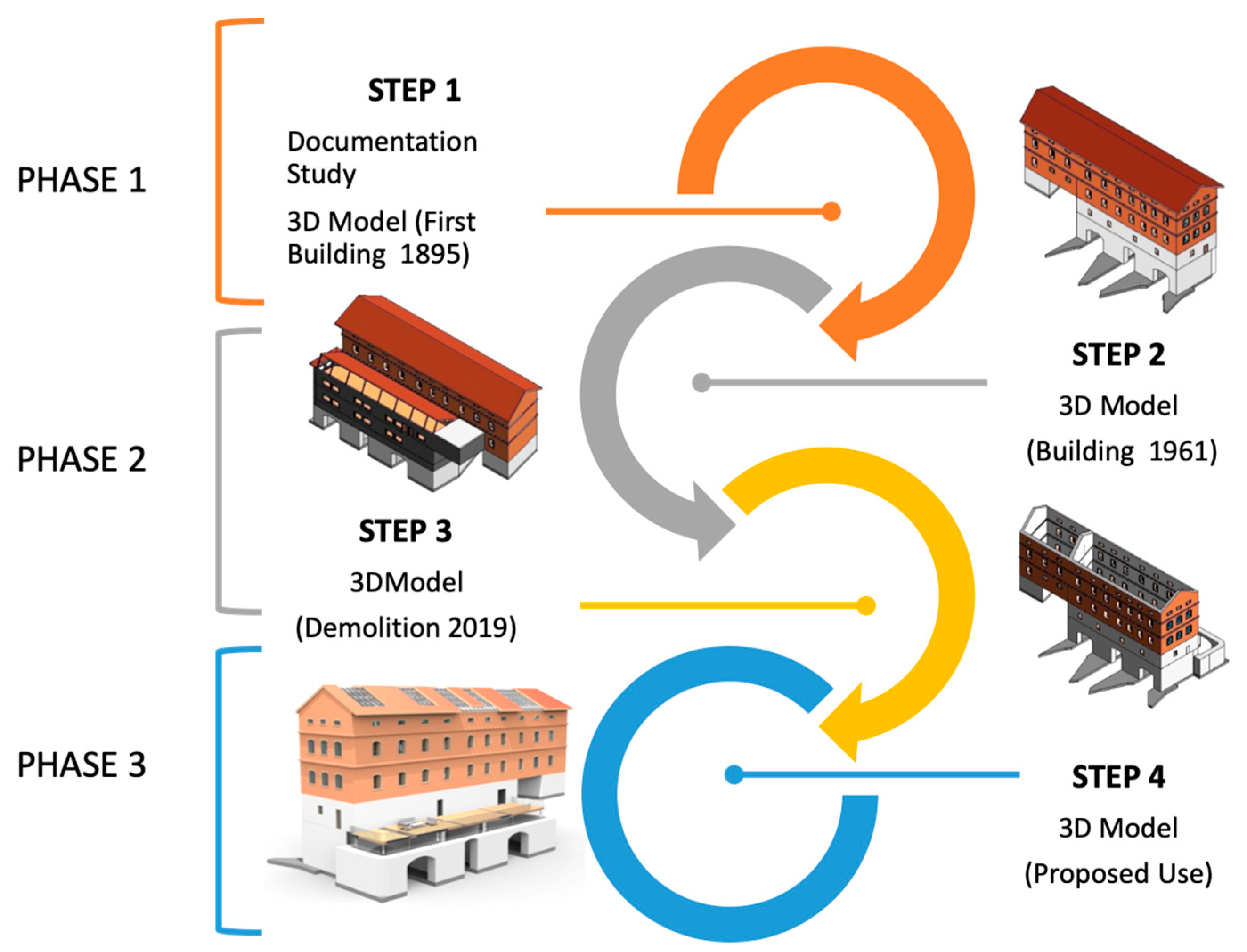
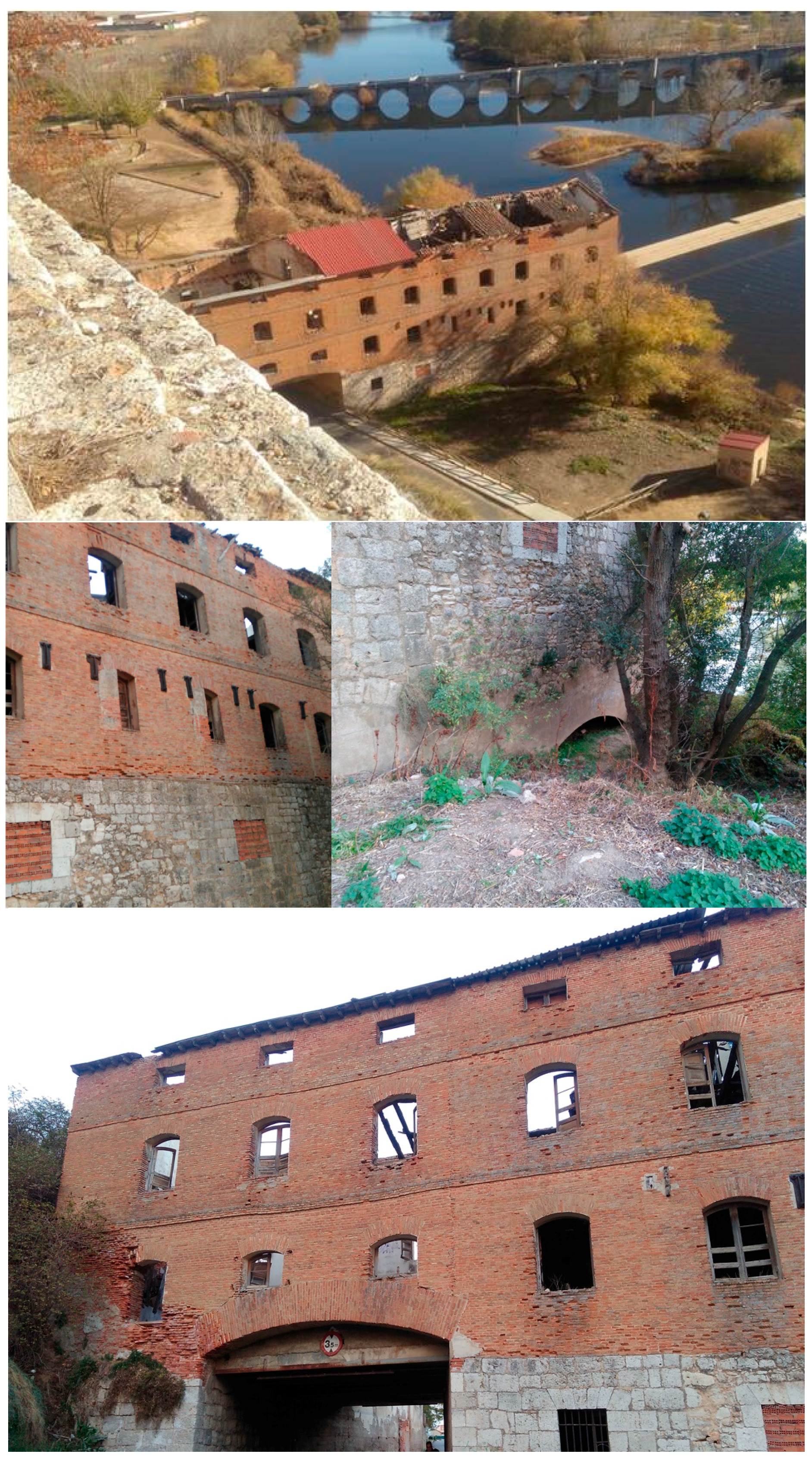

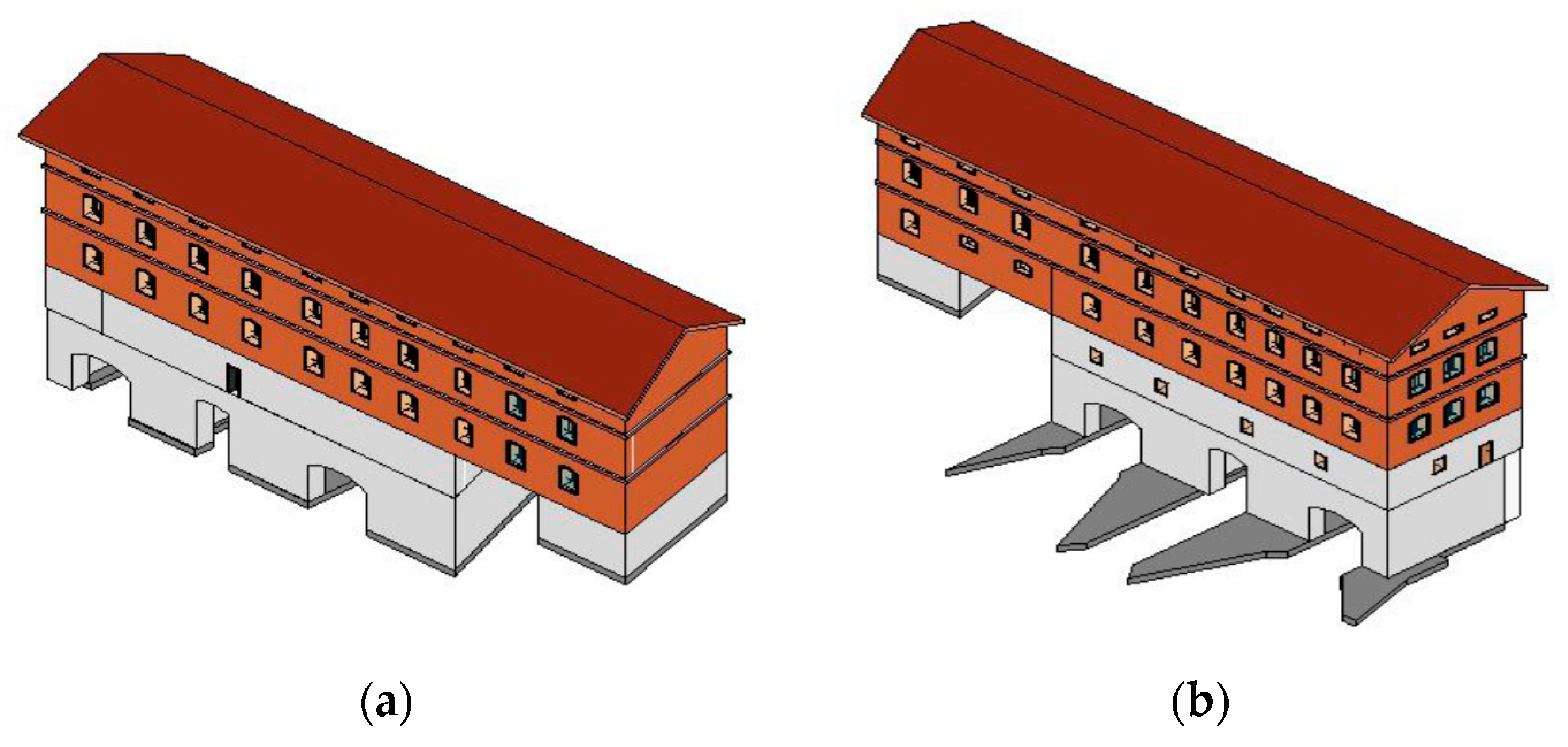
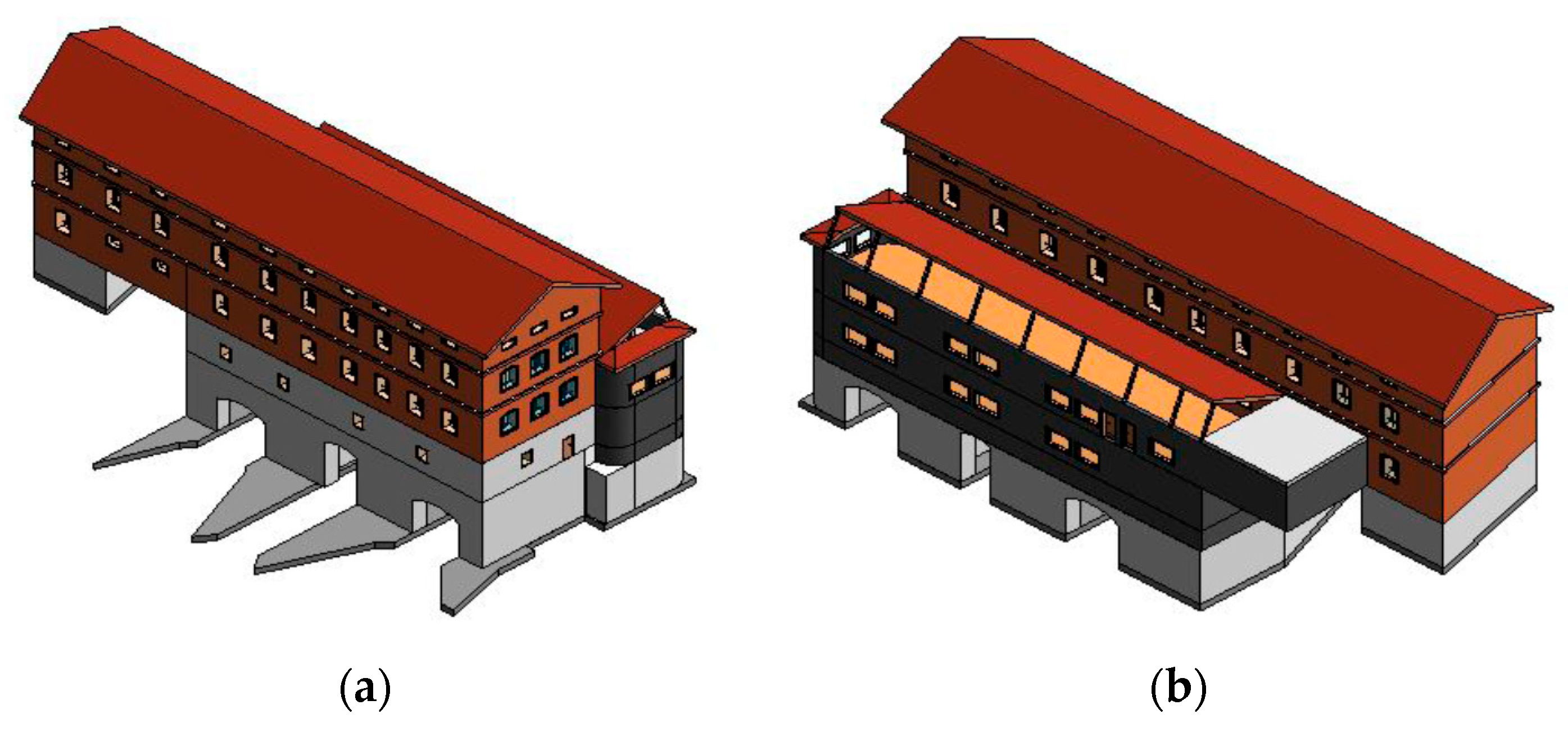
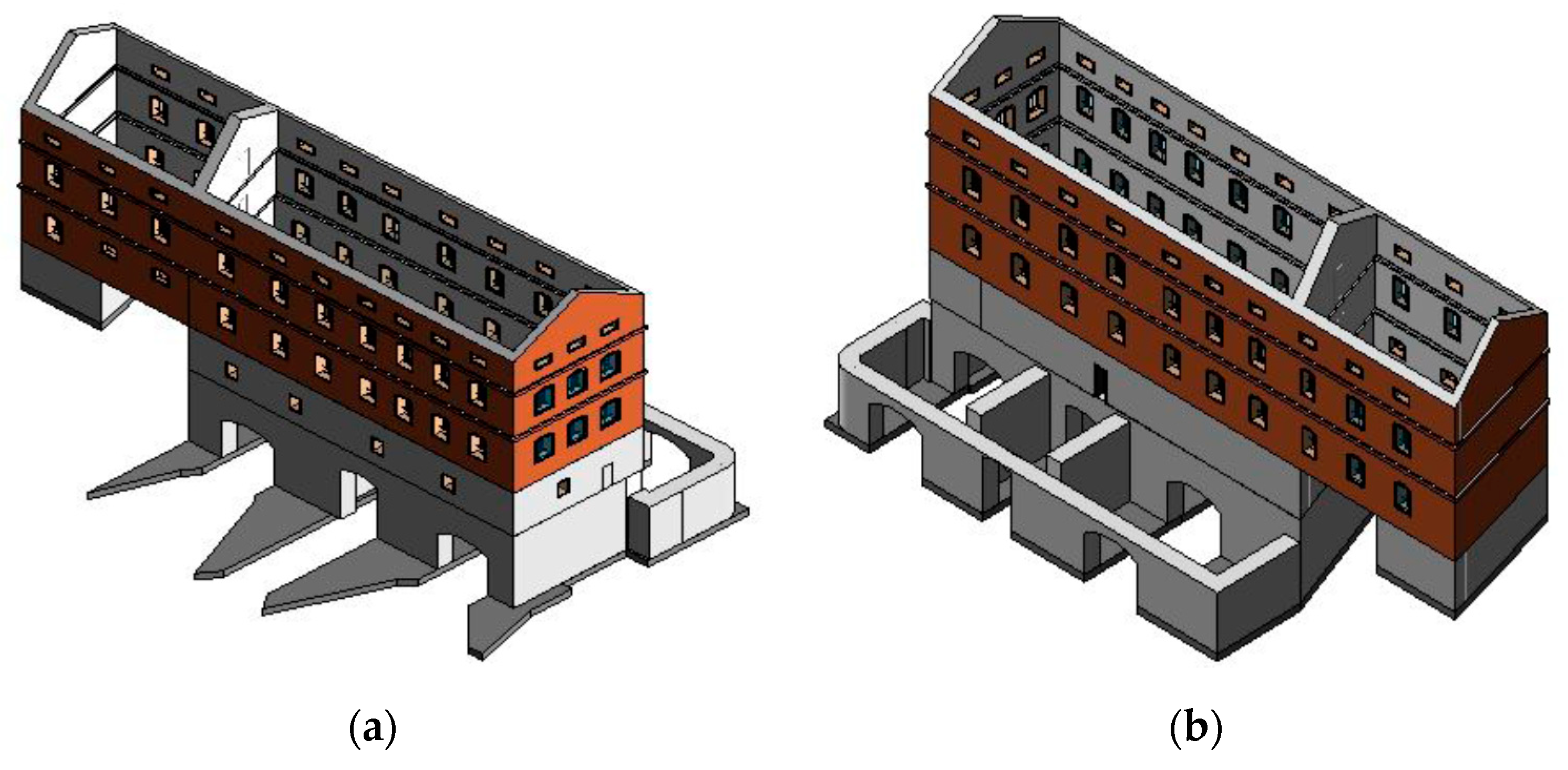
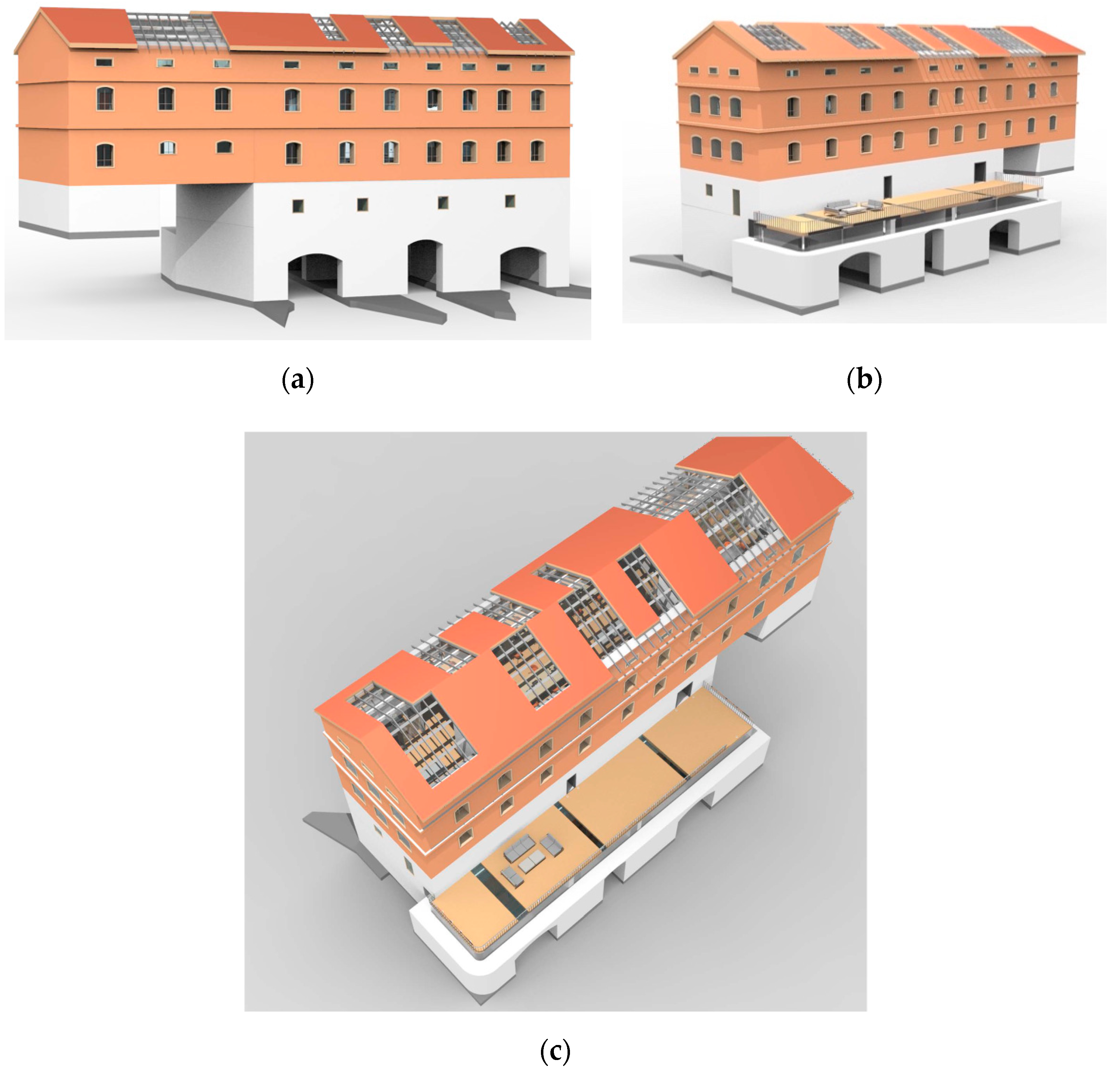
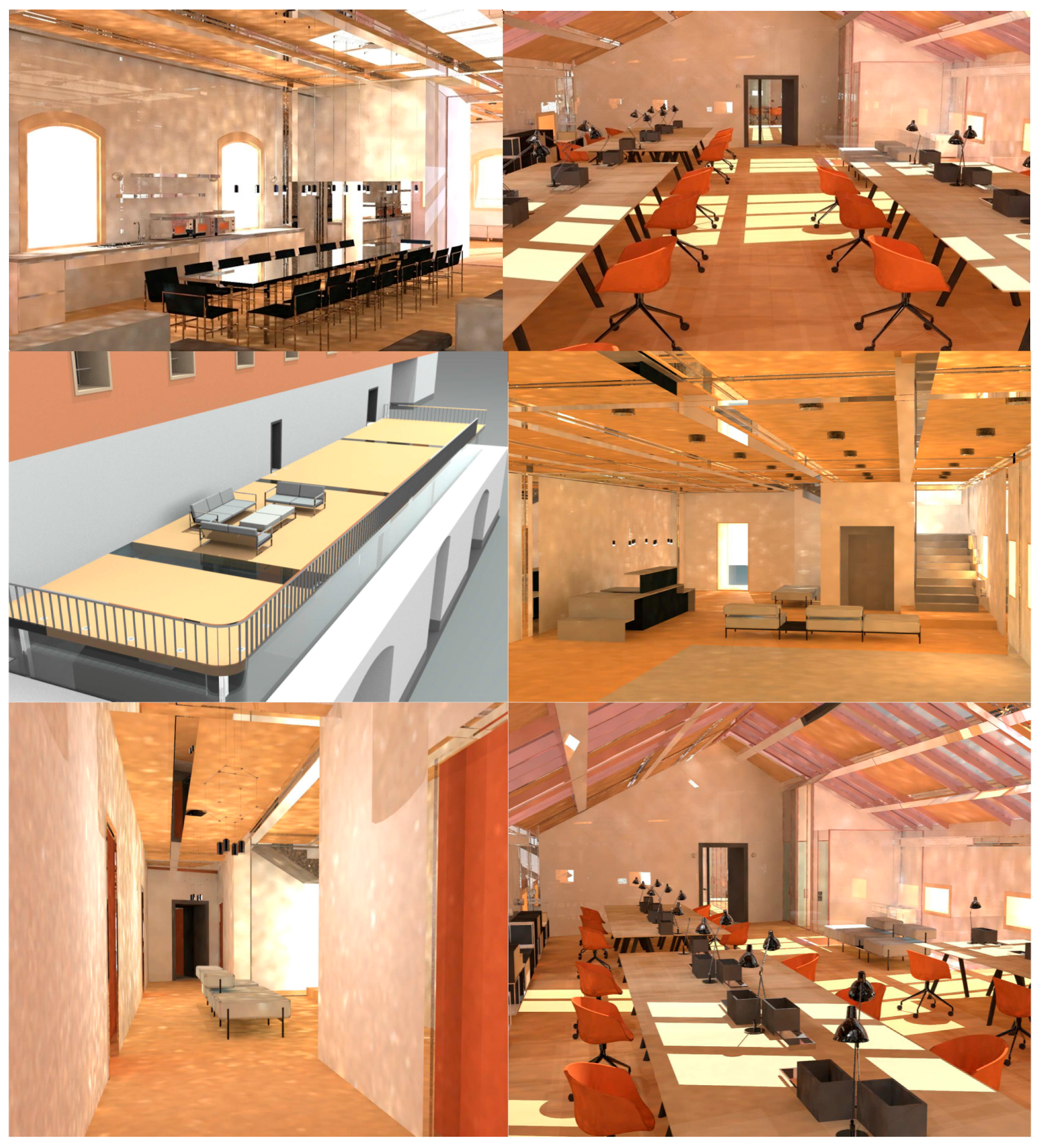
| Author | Theory |
|---|---|
| Viollet-Le-Duc (1814–1879) | The building should retain the style of the period in which it was built. All architectural elements from a different era should be eliminated, thus also eliminating its historical stratification; nondifferentiated lasting intervention of the original historic building. |
| John Ruskin (1819–1900) | Build a new reality on the remains of a pre-existing building. Provide sound maintenance to apply the necessary operations for conservation. Preserve with the greatest respect; |
| Boito (1836–1914) | New forms are distinguished from old forms, highlighting the modernity of the forms; Restoration Charter. |
| Cesare Brandi (1906–1988) | Safeguard value other than functional value. |
| Torres Balbás (1888–1960) | Respect the passage of time; understand the building as a historical document; preserve rather than restore; use recognizable materials to facilitate their subsequent identification; conduct a historical study of the building; Athens Charter. |
© 2019 by the authors. Licensee MDPI, Basel, Switzerland. This article is an open access article distributed under the terms and conditions of the Creative Commons Attribution (CC BY) license (http://creativecommons.org/licenses/by/4.0/).
Share and Cite
Sánchez, A.; Gonzalez-Gaya, C.; Zulueta, P.; Sampaio, Z.; Torre, B. Academic Proposal for Heritage Intervention in a BIM Environment for a 19th Century Flour Factory. Appl. Sci. 2019, 9, 4134. https://doi.org/10.3390/app9194134
Sánchez A, Gonzalez-Gaya C, Zulueta P, Sampaio Z, Torre B. Academic Proposal for Heritage Intervention in a BIM Environment for a 19th Century Flour Factory. Applied Sciences. 2019; 9(19):4134. https://doi.org/10.3390/app9194134
Chicago/Turabian StyleSánchez, Alberto, Cristina Gonzalez-Gaya, Patricia Zulueta, Zita Sampaio, and Beatriz Torre. 2019. "Academic Proposal for Heritage Intervention in a BIM Environment for a 19th Century Flour Factory" Applied Sciences 9, no. 19: 4134. https://doi.org/10.3390/app9194134
APA StyleSánchez, A., Gonzalez-Gaya, C., Zulueta, P., Sampaio, Z., & Torre, B. (2019). Academic Proposal for Heritage Intervention in a BIM Environment for a 19th Century Flour Factory. Applied Sciences, 9(19), 4134. https://doi.org/10.3390/app9194134






